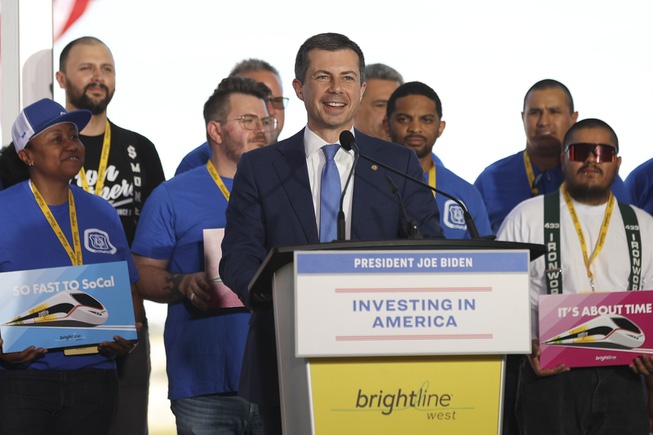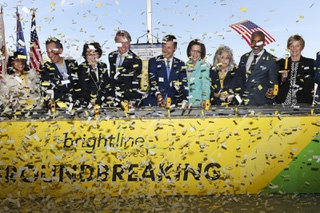
U.S. Transportation Secretary Pete Buttigieg speaks during Brightline West’s groundbreaking ceremony Monday, April 22, 2024.
Tuesday, April 23, 2024 | 2 a.m.
The nation’s first true high-speed passenger rail system is within grasp with the ceremonial groundbreaking Monday of the Brightline West link between Las Vegas and Southern California.
The Brightline West project, a 218-mile, all-electric rail system slated for construction along the infamously congested Interstate 15 corridor, kicked off Monday morning at the site of its future Las Vegas Station in the central valley, with hundreds in attendance, from legislators and local business leaders to union contractors and other stakeholders.
“I am firmly convinced that once the first customer buys that first ticket to ride through high-speed rail on American soil, there will be no going back,” Pete Buttigieg, U.S. transportation secretary, said during the event. “People will demand and expect this everywhere, and leaders will respond. And more high-speed rail lines are coming.”
In other words, he joked, what happens with Brightline West in Las Vegas should “absolutely not be confined to Las Vegas.”
The Brightline West rail, with a completion target of 2028 — just in time for Los Angeles to host the Summer Olympics — will travel at an average of 186 mph, cutting the commute via land between Las Vegas and Southern California down to just two hours, Buttigieg said.
The zero-emissions way of transport will also lead to 800 million fewer pounds of carbon pollution annually, he added Monday, which was coincidentally also Earth Day.
“Today answers the question that has been asked too often, likely,” Buttigieg said. “The question whether America can still build massive, forward-looking engineering marvels that make people’s lives better for generations … and this is just the start.”
Speakers at Monday’s event repeatedly expressed their gratitude to Buttigieg, President Joe Biden and his administration as a whole for the federal government’s funding of a portion of the Brightline West project, and their investment in infrastructure overall.
The $12 billion project received $3 billion in grant funding from the federal government in December, as part of the 2021 Infrastructure Investment and Jobs Act, or the Bipartisan Infrastructure Law.
“This project, which will run the length of my congressional district, represents the very best of American innovation and ingenuity,” said Nevada Democratic U.S. Rep. Susie Lee. “By harnessing cutting-edge, high-speed rail technology, you’re creating a new era of transportation that will transform the way we travel between Las Vegas and Los Angeles. No longer will we or our visitors be stuck in traffic for hours on end.”
The project is not solely about getting “from point A to point B” faster, however, but also creating jobs and boosting the local economy, said Lee, who was joined by her House colleagues, Nevada Reps. Dina Titus and Steve Horsford, and California Reps. Norma Torres and Pete Aguilar.
The high-speed rail, which will have train stations spanning tens of thousands of square feet in Las Vegas, Victor Valley, Hesperia and Rancho Cucamonga, Calif., is poised to generate as much as $10 billion in economic impact, while also creating 35,000 good-paying union jobs, said U.S. Sen. Jacky Rosen., D-Nev., a longtime advocate of the project.
“After years of promises and years of lip service, we finally have all the funding needed, all the approvals, all the permits, all the union workers, and there’s only one thing left to do now to get this party started,” she said, accompanied on stage by U.S. Sen. Catherine Cortez Masto, D-Nev. “We need to build it. And that starts today.”
Nevada Gov. Joe Lombardo, against a backdrop of the American flag framed by two large cranes and the Las Vegas Strip visible just beyond the podium, praised the “public-private partnership” that has made the Brightline West project possible, and noted that it will also save lives on the roadways — in addition to its positive effect on the economy.
“I’m confident that the Brightline West project will continue to create economic opportunity and jobs across the West and here in Nevada,” said Lombardo, who also recognized former Gov. Steve Sisolak and a slew of other stakeholders who have contributed to the innovation and creation of the Brightline high-speed rail. “The state of Nevada is excited about this project, and we look forward to being exemplary partners to Brightline, as the work gets underway on this project.”
Four years from now, the U.S. will no longer be the only industrialized country in the world that does not have high-speed rail, said Wes Edens, founder of Brightline, which also operates a passenger rail system in Florida.
Just as the Hoover Dam was built nearly 100 years ago, providing a foundation for success and growth in Southern Nevada, so he believes Brightline West will leave a lasting impact on the region and the U.S. overall, Edens said.
“What I believe will be the legacy of today is, this is really the start, the beginning, of the high-speed rail industry,” Edens said. “And what I mean by that is — we have an automobile industry. We have an airplane industry. There’s no reason the United States of America should not be the leader in the world for (the) high-speed rail industry.”
A project this gigantic requires “everybody to say ‘yes,’ ” Edens said, and he’s grateful for the unbelievable support that Brightline has received at every level — from federal, to state to local government.
“Our vision is this blueprint can be repeated all over this great country,” he said, pointing to cities within close proximity like Dallas and Houston. “There are many, many trains we need to build and will be built as a result of what we’re doing out here right now.”
In response to a question about how much tickets for the high-speed railway would cost, Edens told members of the media before the event that train prices have to be competitive with flights and driving, and he views anywhere between 50 cents to $1 per mile as a good metric.
But, he emphasized, Brightline is still four years away from having to cement pricing.
“For decades, America did not invest in passenger rail the way other countries did,” Buttigieg said during the event, flanked by contractors who will be participating in construction of the project. “Some voices in Washington even strangely suggested that America was somehow incapable of having world-leading passenger rail. But of course America can, and always should, lead the way in any technology, as indeed we did in the development of a railroad itself as a concept.”
Brightline West and other infrastructure projects are aimed at making life easier for people, creating good union jobs, reducing pollution and ultimately leaving a stronger and fairer country to the next generation, he said.
“So thank you, everyone,” Butigeig said before the ceremonious groundbreaking at the event, which also featured remarks from Vince Saavedra, executive secretary treasurer at Southern Nevada Building Trades, and Steve Benjamin, senior adviser to Biden. “Thank you for helping bring that vision to life, because we are making history. Let’s go build that railway.”

